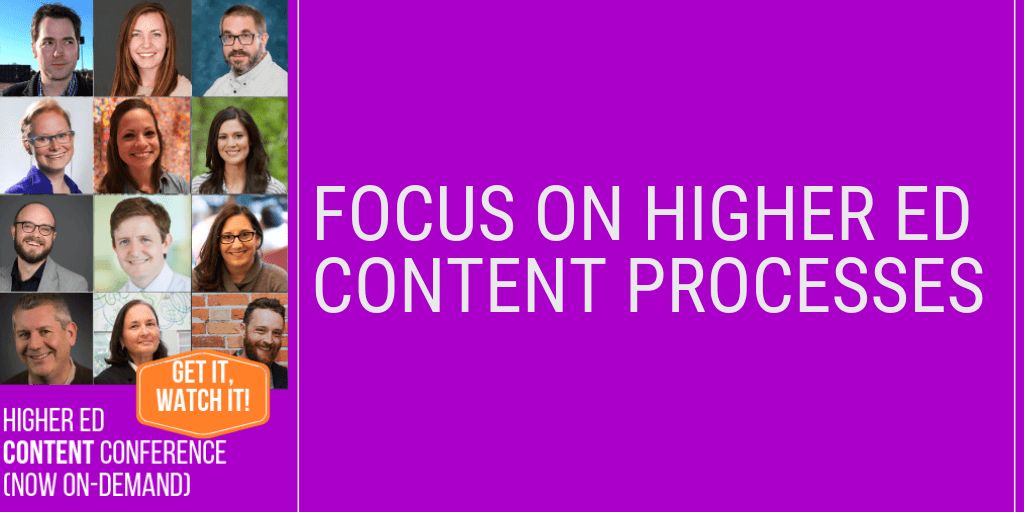Get ready for 2020 with the Higher Ed Social Media Online Conference #hesm #highered 4 Nov 2019 4:19 AM (5 years ago)
Has everybody on your team gone to a conference this year?
Whether it’s for budget reasons, lack of time or even family matters, it’s not always possible to get everybody to fly across the country to attend one of the great higher ed conferences out there.
That’s why I launched – back in 2013 – the Higher Ed Experts Online Conferences, to offer an affordable alternative to spend a day with your team or user group on campus to learn best practices and get energized.
The good news is that the 7th Higher Ed Social Media Conference will take place on December 4, 2019.
Why should you team attend the 7th annual Higher Ed Social Media Conference?
Let me give you 5 reasons to register your team for this live online conference
1) This conference can make ALL your team members SMILE (again?)…
And, I have “scientific” proof to back up this claim. Just look at the photos the conference attendees and speakers shared during the last edition:
#HESM18 Conference Win Wall :-) (100% troll free!)
2) Ok, more seriously, attendees just love this conference
Attendees and speakers always feel energized by this live event as you can see in the slideshow below created with the feedback they shared in their online evaluations (you got their names, so you can also ask them directly as well):
3) There’s something in the program for everybody on your team
This year again the program is fantastic and 100% focused on social media for higher ed.
With 12 sessions scheduled, you get a great variety of topics presented by higher ed professionals who know social media for higher ed.
We have seasoned presenters some of you might have seen at other higher ed conferences as well as brand new voices with very original ideas.
Several of the conference presenters attended the event before, so they definitely walked in your shoes and will be ready to deliver the kind of sessions you want to see as an attendee. :-)
4) The conference is fast-paced and on topic
Your colleagues who attend Higher Ed Experts’ online conferences can’t stop raving about the format of our conferences.
With 12 sessions of 10 minutes each, the 7th Higher Ed Social Media Conference is the perfect format to provide professional development for your social media user group (SMUG) and spark great ideas within your social media team.
More and more institutions sign up for the event, book a conference room or a large auditorium, set up a big screen and invite as many people as possible to attend the live event. Krista Boniface, Social Media Officer at the University of Toronto, wrote a post to share some great tips on how to host a watch party for your goup.
Since the recordings are available for a year, you can also use these recordings to start a conversation with your team in monthly “lunch & learn” meetings.
After watching a 10-minute recording, it’s really easy to brainstorm around the ideas or best practices discussed in the session. That’s professional development that keeps on giving!
5) It’s the most wonderful time of the year…
Scheduled on December 4, 2019, the conference is just after Thanksgiving but before the big rush leading to the end of the year.
It’s also a great way to thank and energize your team with insightful professional development — without breaking your budget (you can have as many people as you want in a room for 1 registration fee) or worrying about travel delays or headaches (remember? It’s online AND recorded).
Too good to be true? You’re right, there’s a catch: available virtual seats are limited. We’re getting very close to running out of available seats. If you want to attend this conference with your team, register while you still can.
Present at the 7th #HigherEd Social Media Conference: Submit a #hesm proposal by Sep 18, 2019 10 Sep 2019 5:17 AM (5 years ago)
The 7th Annual Higher Ed Social Media Conference (Dec 4, 2019)
The Higher Ed Social Media Conference has been a big hit with the community since its launch in 2013.
Every year, several hundred participants working for colleges and universities in the US, Canada and the UK gather around big and small screens to attend this must-attend conference for higher ed social media teams looking for inspiration, advice and best practices to borrow.
Top 5 reasons why presenting at the #HESM Conference is even better than attending
I’ll give you 5 reasons to submit a speaking proposal (before Sep 18, 2019 – next Wednesday) for the Higher Ed Social Media Conference:
- it’s composed of 10-minute sessions, so – as a presenter and a busy social media pro – you can focus on the essential points (no extra fluff required) AND deliver a fantastic learning experience for attendees
- it focuses entirely on social media in higher education, so you get to connect and interact with social media professionals facing similar challenges
- it’s a great way to get noticed by your peers, their bosses or even other conference organizers interested in social media (even if you’ve never presented before at industry events – don’t believe me? Read these presenter stories from 3 of your higher ed colleagues)
- it’s an opportunity to connect with top voices in higher ed social media
- it doesn’t require a budget to present AND will even help you save some professional development money, because there is no need to travel AND presenters receive a free pass ($525 value) to attend the whole event WITH their team!
Need another reason to submit a proposal to the ONLY online conference that makes attendees smile?
Here’s a selection of photos shared by the attendees of the 2018 edition of the confernece.
Please scroll down through them to answer a quick question.
#HESM18 Conference Win Wall :-) (100% troll free!)
Have you noticed the “smiling pattern” on these photos?
Year over year, it’s consistent: the audience is happy and engaged. No small feat for an online conference!
That’s why you should submit a proposal – what speaker doesn’t dream of a smiling audience, right?
So, let’s make the 2019 conference program as good as (or even better than) the previous editions with your conference proposal(s)!
You’ve got less than 1 week left to submit your proposal!
Please dot it ASAP.
Oh, and Sep 18, 2019 is a hard deadline – it won’t be postponed, because the conference program will be announced on Sep 25, 2019.
Whether or not your proposal is accepted, you will get notified super fast.
Not ready to present, but want to attend the conference?
The early bird discount will expire on Sep 18 as well, so grab a seat fast if you want to snatch a great deal for your team!
You can register now and secure your seat via credit card.
Got questions?
I love questions! Just post your question(s) below or you can also email karine@higheredexperts.com
2019 Higher Ed WEBSITES Conference: watch on-demand with 1 extra session released soon 10 Jun 2019 3:29 AM (5 years ago)
Did you miss the #HEW19 conference on June 5? Watch it on-demand!
The 2019 Higher Ed WEBSITES Conference was a really fun and engaging experience (check out the pics!) for all the American, Canadian and Australian schools in attendance – and you can now get it on-demand!
The 2019 Higher Ed WEBSITES Conference was full of fresh ideas, best practices, great takeaways in the sessions as well as the Q&A session – with all the speakers on screen – we streamed live on Facebook (totally unfiltered as you’ll see with the mix-up at the beginning)!
More coming soon!
Whether you registered for the live conference or get it now on-demand, you will also get access to an extra bonus session (the 13th one!) to be released on-demand this month – at no extra cost :)
Website Redesign Process: From Discovery to Information Architecture
Ryan MacDowell, Communications Strategist at MIT’s Teaching + Learning Lab (to be released on June 19)
How do you redesign a website to better support faculty, staff and administrators to create an educational environment where students are academically challenged and actively engaged? That’s what the MIT Teaching + Learning Laboratory went through over the past year. In this case study, Ryan MacDowell shares the internal process undertaken to establish and maintain clarity, while overcoming decision-making challenges during the discovery and site planning phases.
A conference focusing on higher ed WEBSITES?
The 2019 Higher Ed WEBSITES Conference is a must for higher ed web professionals and teams looking for inspiration, ideas and best practices to kick off their summer projects.
Read below what a few of your higher ed colleagues who attended the Higher Ed WEBSITES Conference say about the experience.
2019 Higher Ed Content Conference: watch on-demand with 3 extra sessions released in May 30 Apr 2019 11:33 AM (5 years ago)
Did you miss the #HECO19 conference in April? Watch it on-demand!
The 2019 Higher Ed Content Conference was a really fun and engaging experience (check out the pics!) for all the American and Canadian teams in attendance a couple of weeks ago – and you can now get it on-demand!
The HECO19 conference was full of great takeaways, fresh ideas and surprises including a 27-min Q&A session with all the speakers on screen we streamed live on Facebook (skip the first minute for the start :)!
Extras, Extras, Extras!
Whether you registered for the live conference or get it now on-demand, you will get access to the 3 following bonus sessions (which brings the total to 15) to be released on-demand this month – at no extra cost :)
Repurposing content through digital channels: How to do a lot with a little (to be released on May 1st)
Salma Nawlo, Assistant Director of Communications – Florida Southern College
Your campus community is always bustling with news about a professor, a student or an alum. Rewards and recognitions, hands on collaborations and partnerships, internship and outcome successes — those are the stories that matter and the ones we cover. But digital content rarely lives to see another day. In this session, Salma Nawlo will show how you can efficiently and effectively bring all this content back to life — often. Youâ€ ll get tips, tricks and ideas to make the most of all the content distribution channels at your disposal.
ll get tips, tricks and ideas to make the most of all the content distribution channels at your disposal.
Ask Me Anything: Instant Gratification on Instagram Stories (to be released on May 15)
Ashley Muckway, Digital Marketing Assistant – Fort Lewis College
Todayâ€ s students donâ€
s students donâ€ t want to wait – they want everything RIGHT NOW! From chatbots on websites to overnight shipping, you can see this trend everywhere. In this session, Ashley Muckway will talk about how we can deliver instant gratification on social media, specifically through Instagram Stories. The new “ask me anything†(AMA) feature on Instagram Stories opens a casual means of communication between the user and the school, leading the students to feel more comfortable about asking the “small†questions. Youâ€
t want to wait – they want everything RIGHT NOW! From chatbots on websites to overnight shipping, you can see this trend everywhere. In this session, Ashley Muckway will talk about how we can deliver instant gratification on social media, specifically through Instagram Stories. The new “ask me anything†(AMA) feature on Instagram Stories opens a casual means of communication between the user and the school, leading the students to feel more comfortable about asking the “small†questions. Youâ€ ll learn how easy it is to start, promote and deliver an AMA session to provide engaging and informative content to your audience.
ll learn how easy it is to start, promote and deliver an AMA session to provide engaging and informative content to your audience.
How I Created a Digital Magazine and Content Hub for Virtually Nothing (to be released on May 29)
Laura Braddick, Assistant to the Dean, Strategic Communications – Towson University College of Business and Economics
For years, the college had been producing a great print magazine for business school alums and donors. It was long past time to put the content online, but with no budget and virtually no resources to build a separate magazine site, we got creative and used resources already available to us on campus to develop a beautiful digital magazine using WordPress. Not only is our magazine now fully online, but it created a platform for publishing content we can push out through social media. We can also track metrics with Google Analytics and much more. All of this was done with no extra hard costs out of our department’s budget.
A conference focusing on higher ed content?
The Higher Ed Content Conference is a must-attend event for higher ed content professionals and teams looking for new ideas and best practices.
Read below what a few of your higher ed colleagues who attended the past editions of the Higher Ed Content Conference say about the experience.
How higher ed content is made: 12 content processes shared 15 Mar 2019 3:02 AM (6 years ago)
What do content creation processes look like in higher education?
Not in theory, not in conference presentations, not in 280 characters (or more), but in reality?
While we all have access to the great content created by our professional peers, itâ€ s rare to get details on the different processes behind the higher ed content we see published on the web or shared on social media.
s rare to get details on the different processes behind the higher ed content we see published on the web or shared on social media.
So, I asked the speakers of the 2019 Higher Ed Content Conference to share how the “content sausage†is made at their school.
Check out these 12 takes on the higher ed content process and get inspired!
#1 Corie Martin, Director Web Services & Digital Marketing – Western Kentucky University
 At WKU, our content strategy is collaborative, theme-based, and emotion-driven. It is guided by the prospective student recruitment cycle; by the first semester, first year student experience; and by our mission to remain a student-centered, applied research institution.
At WKU, our content strategy is collaborative, theme-based, and emotion-driven. It is guided by the prospective student recruitment cycle; by the first semester, first year student experience; and by our mission to remain a student-centered, applied research institution.
We start each academic year (August-July) by taking an actual calendar, which in our case is a shared Google calendar, and we assign a theme to each month that will then drive our content.
Typically, the themes we choose are based on things that prospective families would want to know about our institution based on where those students might be in the recruitment cycle/funnel. For example, January had a theme of, “New Beginningsâ€, because it represents a new year, a new academic term, and many prospective students are making their college decisions during this time. We also consider the emotions that are tied to various stages of the college choice process such as excitement or anxiety, and we strive to produce content that either evokes or calms those emotions.
At the same time, we are also producing content that will assist our current students, particularly our first-year students who need more support and assistance. Understanding that involvement and engagement are keys to student retention, in February, our theme was “Broaden Your Horizonsâ€, which highlighted ways to get involved and extend learning opportunities beyond the classroom. For a week we covered study abroad, for another week we covered internship opportunities, we also covered volunteerism activities. These content pieces also spoke to prospective students who are beginning to research and become excited about all the diverse opportunities that are available to them in college.
Our content strategy is collaborative because we utilize our entire campus community to help us find out what programs and students to feature. Representatives from each of our five academic colleges feed us content, as do a variety of student service offices.
We also use a team of volunteer social media squad students to produce this content. Our marketing team is fairly small for an institution our size, so we all jump in to help to create content pieces that are disseminated via newsletter, news blog, and social media.
We are also in the process of creating messaging and timing for various audiences on various platforms, all based on data. We use personas to keep us focused on the audience for whom we are producing content and we no longer just produce one piece of content for all audiences, as not all audiences are in the same place at the same time.
#2 Jeanna Balreira, Creative Director – Trinity University
 At Trinity, content is collaborative.
At Trinity, content is collaborative.
The Office of Strategic Communications and Marketing produces written, video, and photographic content for print and digital distribution.
Most content can be categorized as being “partnership†content—produced for partners in enrollment, alumni relations, development, and the Office of the President—and “campus†content, brand stories that highlight faculty, students, staff, and campus news. Our team has a staff video producer, creative producer, brand journalist, digital marketing manager, managing editor, and creative director; we produce stories broadcast on our website (thanks to our awesome web team), published in print (thanks to our great designers), and shared on social (thanks to a team of great interns).
In a weekly meeting, the content team discusses upcoming stories and topics as well as any urgent communication that needs to be written for the campus. Throughout the week, story creators discuss their progress with the managing editor, who works closely with the digital marketing manager to schedule timely communications for our prospective students, alumni, and everyone in between.
Constructive, collaborative feedback is vital to our process: everyone on the content team is empowered to both teach and learn as we evaluate success. This includes crossing media, as writers can give feedback on videos, creatives can give feedback on writing, etc. This allows us to think like different viewers—which we are!
#3 Salma Nawlo, Assistant Director of Communications – Florida Southern College
 Florida Southern College’s Enrollment Marketing team of four is mainly responsible for prospective student outreach. The material produced comes in the form of web, print, social, and email.
Florida Southern College’s Enrollment Marketing team of four is mainly responsible for prospective student outreach. The material produced comes in the form of web, print, social, and email.
Collecting content to feed these platforms requires reaching out to the various college community members, which would include professors, staff members, current students, and even alumni. The information collected from these members typically consists of the “latest happenings” on campus, which can be about engaged learning experiences, recognition and awards, internships, study abroad experiences — or anything else, college-related that can be shared with high school counselors, prospective students, and even their parents.
My job as the assistant director of communications is to collect this content by way of creative methods. Over time, I have developed programs and partnerships with multiple areas on campus that would allow content to be fed through consistently.
For example, our partnership with the Student Travel Office brings in student blogs from each of the study abroad trips we host. These blogs serve as testimonials and engaging stories that we can repurpose for the various platforms. I also have an agreement with certain professors who are happy to blog once a month about their field. In these blogs, they talk about their one-on-one relationships, their brilliant students, or just their expertise in general.
#4 Jeff Bunch, Web Content Strategist – Gonzaga University
 Weâ€
Weâ€ ve changed the cadence of our core storytellers team to have more regular check-in meetings as we attempt to tell more stories across campus for both internal and external audiences.
ve changed the cadence of our core storytellers team to have more regular check-in meetings as we attempt to tell more stories across campus for both internal and external audiences.
Weâ€ ve also invited key departments on campus into our meetings each semester to share current initiatives with us. As a member of the web and storytelling teams, my role continues to be a web liaison between the two functions in our division and to help envision content within new sections of our website to execute on our broader strategies.
ve also invited key departments on campus into our meetings each semester to share current initiatives with us. As a member of the web and storytelling teams, my role continues to be a web liaison between the two functions in our division and to help envision content within new sections of our website to execute on our broader strategies.
In the past year, weâ€ ve created collections of content to better draw in viewers and help them find similar content more easily.
ve created collections of content to better draw in viewers and help them find similar content more easily.
Our biggest success was our 2018 graduation section, where we executed a plan for all graduations on campus. Our biggest story out of those efforts was simply publishing the transcript of the undergraduate speaker address, “Cannonball: A Gift to Gonzaga Grads,†which went viral nationally across Jesuit websites.
#5 Janet Gillis, Communications & Marketing Officer – USF College of Engineering
 At the University of South Florida College of Engineering our content creation process started by building strong relationships with key stakeholders in the College and across the University. The faculty and students know we are the go-to folks for getting their stories out. They are comfortable reaching out with information about research funding, awards, community outreach events, alumni and donor gifts.
At the University of South Florida College of Engineering our content creation process started by building strong relationships with key stakeholders in the College and across the University. The faculty and students know we are the go-to folks for getting their stories out. They are comfortable reaching out with information about research funding, awards, community outreach events, alumni and donor gifts.
I also get information from the research and innovation division and sometimes at the university communications level. While Iâ€ ve never been a reporter, I imagine this is like having a beat. Engineering is our beat and we work it and keep in close communication with the principals in the beat.
ve never been a reporter, I imagine this is like having a beat. Engineering is our beat and we work it and keep in close communication with the principals in the beat.
In my opinion, you canâ€ t be successful unless you make the effort to build these relationships. Iâ€
t be successful unless you make the effort to build these relationships. Iâ€ ve been the primary relationship holder for the past 10 years, but I am currently grooming my communications specialists to start building these relationships, as well.
ve been the primary relationship holder for the past 10 years, but I am currently grooming my communications specialists to start building these relationships, as well.
#6 Shay Galto, Manager of Marketing Analytics – University of Denver
 As the Manager of Marketing Analytics, my role is to work with our content team throughout the creation process and to analyze the success of the content after it has been displayed. As frequently as possible, we work together at onset to establish key performance indicators (KPI) for our website, social, and written content.
As the Manager of Marketing Analytics, my role is to work with our content team throughout the creation process and to analyze the success of the content after it has been displayed. As frequently as possible, we work together at onset to establish key performance indicators (KPI) for our website, social, and written content.
From there, we build out a map that loads the content into our KPI buckets. Our Content Manager or Manager of Social then works with campus constituents to build the content. Whether the content is displayed through web, email, or social, we all work together to make sure we are appropriately tracking and analyzing the content.
We later use the analysis to inform future content based on what resonated most with our constituents. What makes all of this work so well is the collaboration between the teams involved. Our content team does an outstanding job keeping all of the pieces moving in the same direction. We could improve by performing this process throughout all of our projects (even the last minute ones!).
#7 Emily Mayock, Online Communications AVP – Case Western Reserve University
 No matter what the piece of content is, its creation is almost always a collaboration in some way—whether we start with a brainstorming meeting, shoot a quick email or Gchat to another person for their take on an idea, get help with a great lede, or even write solo but come together to transform the words into a website, print piece or social media campaign.
No matter what the piece of content is, its creation is almost always a collaboration in some way—whether we start with a brainstorming meeting, shoot a quick email or Gchat to another person for their take on an idea, get help with a great lede, or even write solo but come together to transform the words into a website, print piece or social media campaign.
I’m lucky to work with a fantastic team of creative people to make content in nearly all media. But probably my favorite things to work on are websites—where my team and I can see our ideas evolve from a black-and-white Google doc into an interactive, exciting platform that can inspire and educate people.
Honestly, content creation works well, because our team works well—the only thing I’d change is the ability to have more time to plan ahead!
#8 Rebecca Stapley, Assistant Director of Social Media – Nazareth College
 On my team, for our larger content needs like a specific project or campaign (Giving Day or Admissions Search, for example), we will often begin with a kickoff meeting and brainstorm.
On my team, for our larger content needs like a specific project or campaign (Giving Day or Admissions Search, for example), we will often begin with a kickoff meeting and brainstorm.
In this meeting weâ€ ll address our goals and objectives, audience, channels (most of our projects are integrated at this point: combo of web, social and print) and review past content to assess our needs moving forward. Weâ€
ll address our goals and objectives, audience, channels (most of our projects are integrated at this point: combo of web, social and print) and review past content to assess our needs moving forward. Weâ€ ll then transition into brainstorming and idea mode. Weâ€
ll then transition into brainstorming and idea mode. Weâ€ re always looking to elevate or transform ways to tell the Nazareth College story to help us meet our larger goals.
re always looking to elevate or transform ways to tell the Nazareth College story to help us meet our larger goals.
When we have a solid foundation of ideas and content leads, we always conclude with next steps, deadlines and project management roles. While brainstorming, big picture thinking and idea generation will always be my favorite part of the content process. Iâ€ ve grown to deeply value and appreciate the less exciting aspect of project management to keep myself and the team on-task. Thereâ€
ve grown to deeply value and appreciate the less exciting aspect of project management to keep myself and the team on-task. Thereâ€ s nothing more satisfying than checking of a project milestone, no matter how big or small.
s nothing more satisfying than checking of a project milestone, no matter how big or small.
#9 Kelly Bennett, Manager of Social Media and Marketing Strategy – Miami University (Ohio)
 At Miami University, our university communication and marketing content team, comprised of writers, photographers, and designers, gathers weekly and bi-weekly to plan short term content for the week ahead and long-term content for the month and semester ahead. We work through the filter of presidential priorities to define where to focus our efforts.
At Miami University, our university communication and marketing content team, comprised of writers, photographers, and designers, gathers weekly and bi-weekly to plan short term content for the week ahead and long-term content for the month and semester ahead. We work through the filter of presidential priorities to define where to focus our efforts.
What works well is getting all the right people in the room to brainstorm and share ideas. Something that could improve the process would be adding a sub-group specific to defining the content needs for social media and how all areas can work together to provide the content thatâ€ s timely and relevant in a fast-paced space.
s timely and relevant in a fast-paced space.
#10 Jon-Stephen Stansel, Digital Media Specialist – University of Central Arkansas
 Like many schools, our social media department is a team of one.
Like many schools, our social media department is a team of one.
So, I create the bulk of the content myself. Whenever possible, I try to recycle assets created for other areas, reformatting it to work in each social network.
For example, I might take a graphic element that was designed for a print piece and turn it into a GIF sticker or a Snapchat filter. The idea for our GIPHY channel came from this method, when our photographer had a photo shoot with the mascot for another project. I said, “Hey, while weâ€ ve got the mascot here, letâ€
ve got the mascot here, letâ€ s grab some video and create some GIFs†and it became one of our most successful projects.
s grab some video and create some GIFs†and it became one of our most successful projects.
#11 Andrew Cassel, Social Content Strategist – University of Alaska Fairbanks
 I curate content from wherever I can find it.
I curate content from wherever I can find it.
Some days itâ€ s super easy. A new press release is posted on the news site and I can share it from there. The campus photographer has captured a new a beautiful image that communicates a strong sense of place. A volcano webcam captured a beautiful sunset in remote Alaska. I just craft a post for the news release, share the image, or create a short video or GIF from the webcam footage. Those are normal paths and get content out on the platforms.
s super easy. A new press release is posted on the news site and I can share it from there. The campus photographer has captured a new a beautiful image that communicates a strong sense of place. A volcano webcam captured a beautiful sunset in remote Alaska. I just craft a post for the news release, share the image, or create a short video or GIF from the webcam footage. Those are normal paths and get content out on the platforms.
Then, I create some content myself. I curate playlists for Spotify, make a pop culture GIF to get engagement for a post about deadlines. For the weekends, I try to share evergreen content like student profiles and dig into online sources of entertainment. The library has subscriptions to video streaming catalogs and electronic libraries. Those are great things to share in the evenings or other times when I want to be present in peopleâ€ s feeds but not be reminding them of deadlines or to do their homework.
s feeds but not be reminding them of deadlines or to do their homework.
My ultimate goal with social media for my school is to be a cool friend that offers good information and small moments of delight. The content recipe to achieve is a tasty mix of content provided by others and a content created by me.
#12 Derek DuPont, Social Media Manager – The Ohio State University
 Our first step in creating content is to get really focused on the question of, “who is this for?”
Our first step in creating content is to get really focused on the question of, “who is this for?”
Once we identify our primary audience(s) this helps us determine which platform(s) the content will be created for. From here, we are able to start the process of brainstorming the creative approach and medium with audience and platform strategy in mind. In my role, I work to merge these strategies with the content our teams are creating to maximize the effectiveness of the final product.
A conference focusing on higher ed content?
The Higher Ed Content Conference is a must-attend event for higher ed content professionals and teams looking for new ideas and best practices.
Read below what a few of your higher ed colleagues who attended the past editions of the Higher Ed Content Conference say about the experience.
Present at the 2019 #HigherEd Content Conference: Submit a proposal by Feb 13 5 Feb 2019 12:21 PM (6 years ago)
Looking for great presentations for the 2019 Higher Ed Content Conference (April 17)
Welcoming hundreds of participants from close to 70 different institutions based in the US and Canada in April 2018, the 5th edition of the Higher Ed Content Conference was a big success.
This online conference focusing only on content strategy and content processes for higher education will be back this year on April 17, 2019 – and YOU can be part of it and help make it as good as (or even better than) its previous editions with your 10-min presentation proposals!
Top 5 reasons to present at the 2019 Higher Ed Content Conference?
- this online conference focuses entirely on content in higher education, so you get to connect and interact with content professionals facing similar challenges
- it’s composed of 10-minute sessions, so – as a presenter and a busy content strategist, manager or producer – you can focus on the essential and deliver an A-game presentation (no extra fluff needed :-)
- it’s an opportunity to present with top voices in higher ed content
- it’s a great way to get noticed by your peers or other conference organizers interested in content issues for higher education (even if you’ve never presented before at industry events)
- it doesn’t require a budget to present AND will even help you save some professional development money, because there is no need to travel AND presenters receive a free pass to attend this great online conference WITH their team (it’s worth $500).
Want to help advance content strategy and practices in higher education?
Make sure you share your expertise and experience by submitting your presentation proposal for the 2019 Higher Ed Content Conference. The sessions will be 10-minute long, so you only have the time to focus on the most important and useful points.
Please submit your proposal before Feb 13 (next week!), so you don’t miss this great opportunity for your higher ed career :-)
The February 13 deadline to submit a proposal is a hard deadline – it won’t be postponed, because the conference program will be announced on February 20, 2019. So, whether or not your proposal is accepted, you will get notified super fast.
Not ready to present, but want to attend the conference?
We will have a limited number of seats as the online room is capped.
You can register now and secure your seat via credit card
Got questions?
I love questions! Just post your question(s) below or you can also email karine@higheredexperts.com
Top tips for killer analytics reports for #highered 25 Jan 2019 3:33 AM (6 years ago)
When you do analytics work, analyzing the data and unearthing analytics insights are only half the battle. They are crucial steps, but nothing that matters will get done if you canâ€ t drive decision makers to action.
t drive decision makers to action.
So, how can you share and present analytics reports that drive action?
This part of the measurement process is more art than science in higher ed marketing and communication where there isnâ€ t a strong data-driven culture.
t a strong data-driven culture.
So, I asked the 11 higher ed professionals speaking, by my side, at the 2019 Higher Ed Analytics Conference to share their top tips to present effectively analytics reports that lead to change.
Think first about how youâ€ ll share for Karine Joly, Higher Ed Experts Director
ll share for Karine Joly, Higher Ed Experts Director
 Stop looking at reporting as something that is disjointed from the strategic part – and only done to prove you measured something (anything?). Start to think about how you will share data, insights and recommendations as soon as you identify your digital objectives and KPIs.
Stop looking at reporting as something that is disjointed from the strategic part – and only done to prove you measured something (anything?). Start to think about how you will share data, insights and recommendations as soon as you identify your digital objectives and KPIs.
If you canâ€ t communicate your findings to help decision-makers do their job, whatâ€
t communicate your findings to help decision-makers do their job, whatâ€ s the point in doing all this analytics work?
s the point in doing all this analytics work?
In our new 4-week online courses on higher ed analytics, we even avoid using the word “report†altogether (replacing it with “share†whenever possible), because this key stage of the measurement process comes with a lot of baggage, the expectation that it’s only meant to spew out data in long tables of infinite scrolling and colorful charts. On the contrary, this last step in the iterative measurement cycle should be seen as a launch ramp for decisions and actions. If it sounds like more work, it doesnâ€ t have to be. Weâ€
t have to be. Weâ€ re talking about a cycle, so you can iterate your way to better and better analytics reports.
re talking about a cycle, so you can iterate your way to better and better analytics reports.
Start with the takeaways, not metrics for Jessica Stutt, Integrated Marketing Manager – University of New Brunswick
 When you’re presenting to decision makers you really want to make sure you’re being as clear and concise as possible. These are busy people who likely don’t know the ins and outs of the data you’re presenting.
When you’re presenting to decision makers you really want to make sure you’re being as clear and concise as possible. These are busy people who likely don’t know the ins and outs of the data you’re presenting.
The key is quality over quantity here. Don’t inundate them with every cool Google Analytics metric you can find. (Save that for your fellow higher ed marketing nerds!). Instead, present them with the key takeaways up front and one or two metrics that support those. For example, give them a report that says ‘We’ve succeeded in increasing international prospective student traffic to key admissions pages” and then include one or two visualizations demonstrating the demographic data you’re referencing.
Also, regularly share results with them. Decision makers understand the value of reporting! If you’ve gotten approval of funding to try something new, make sure you follow up with a report on how that effort delivered on its objectives. If it didn’t work, report on it. Explain your evaluation of how the effort can be improved/optimized next time.
All of this can really help to ensure you continue to get investment to support your efforts.
Help them make better decisions for Mandee Englert, Digital Strategist – Penn State University
 Sharing analytics reports that drive action is always a challenge, it isnâ€
Sharing analytics reports that drive action is always a challenge, it isnâ€ t always about analyzing the data itself, it is really about mapping it back with what stakeholders want to see and what is interesting from the results that can help them make better decisions in the future.
t always about analyzing the data itself, it is really about mapping it back with what stakeholders want to see and what is interesting from the results that can help them make better decisions in the future.
My tips for success are:
- Know who will be receiving the deliverable and adopt a language that is suitable for these folks. This often means toning down the analytics language and translating sophisticated metrics into more common data components.
- Map your data back to your business challenge, and stop showing data that doesnâ€
 t affect that overall business goal or challenge.
t affect that overall business goal or challenge.
We want to show every number that we pulled because we are proud and want to show it off, but if it doesnâ€ t relate to the business challenge or what will impact your future marketing strategy – take it out.
t relate to the business challenge or what will impact your future marketing strategy – take it out. - Stakeholders donâ€
 t care about numbers, they care about what the numbers are telling them – you need to tell a story. You should be building your results reports as a story.
t care about numbers, they care about what the numbers are telling them – you need to tell a story. You should be building your results reports as a story.
Make sure you answer these questions:- Why are you providing this analysis?
- Why do the results matter?
- What actions should be taken as a result of this analysis?
Give them what they want for Alan Etkin, Senior Analyst – British Columbia Institute of Technology

Know your audience, their data needs and their data consumption preferences.
Some folks love charts, so give them charts. Other folks go bleary-eyed when they see a chart, so donâ€ t use them, or place them on an underlying page.
t use them, or place them on an underlying page.
- Use Google Data Studio. Itâ€
 s a terrific free tool for delivering highly customized reports for each of your key audiences.
s a terrific free tool for delivering highly customized reports for each of your key audiences. - Limit the number of metrics you use to focus clearly on the needs of the people receiving the report.
- Include year-to-year date comparisons whenever you can. This provides context to the numbers youâ€
 re reporting.
re reporting. - Summarize key insights, to the level appropriate for your audience. This customization is a key step for successfully sharing the data and associated insights.
- And last of all, be sure to highlight your revenue and goal value data. Including dollar signs fundamentally changes the nature of the conversation.
Share the data they care about for Joshua Dodson, Vice President of Marketing and Innovation – VisionPoint Marketing
 Know your audience. Don’t get stuck in the weeds — share the data your audience cares about.
Know your audience. Don’t get stuck in the weeds — share the data your audience cares about.
It wonâ€ t always be the same. If you are sharing information with other analysts, it is appropriate to get into the nitty-gritty analytics. However, that is typically not the case when you are presenting data to key decision makers. A Vice President, for instance, usually wants to know the bottom line: How do the numbers lead to the institution’s goals? Make sure you get to the point quickly. I find it helpful to have the specific details in an appendix or somewhere nearby in case more detailed questions come up.
t always be the same. If you are sharing information with other analysts, it is appropriate to get into the nitty-gritty analytics. However, that is typically not the case when you are presenting data to key decision makers. A Vice President, for instance, usually wants to know the bottom line: How do the numbers lead to the institution’s goals? Make sure you get to the point quickly. I find it helpful to have the specific details in an appendix or somewhere nearby in case more detailed questions come up.
Also, don’t expect your audience to always know what questions to ask. It is important to guide the discussion so that you can provide the data they care most about before they even ask for it. That is a big part of the analyst’s role — anticipating questions and knowing what the audience needs to know. If you immediately start out talking about bounce rate, you have already lost them. Build your story and translate the message into what is important for them.
Talk your reports out for Kris Hardy, Director of Web and Digital Marketing – Messiah College
 Google Data Studio offers some powerful data visualization tools. Leveraging different chart types, breakdown dimensions and styles can take an analytics report to the next level by delivering key performance metrics in a way that is easy to understand and digest.
Google Data Studio offers some powerful data visualization tools. Leveraging different chart types, breakdown dimensions and styles can take an analytics report to the next level by delivering key performance metrics in a way that is easy to understand and digest.
Once a report is built, donâ€ t just send it to the project stakeholders, setup a meeting with them and help them understand the report and guide them through how to interpret the data thatâ€
t just send it to the project stakeholders, setup a meeting with them and help them understand the report and guide them through how to interpret the data thatâ€ s being displayed. In addition, create a channel for dialogue based on feedback from the reports to make them actionable.
s being displayed. In addition, create a channel for dialogue based on feedback from the reports to make them actionable.
Visualize the story for Avinash Tripathi, Executive Director of Analytics – Kaplan Higher and Professional Education
 Build trust with stakeholders (most important)
Build trust with stakeholders (most important)
Visualize the story: plan for a “punchline.”Our CEO, Greg Marino, often asks for a 30-second elevator pitch before we even start the presentation, develop that punchline.
- Enormous amounts of student data are currently being collected by both traditional and non-traditional universities in US and globally starting from on-boarding a student. Differentiate the strategic insights from the “noise†in your enormous data repository.
- Put yourself in the decision makerâ€
 s shoes and ask yourself if the information you present is distracting enough. Does it include an “aha†moment that is actionable?
s shoes and ask yourself if the information you present is distracting enough. Does it include an “aha†moment that is actionable? - Develop a culture of experimentation, propose as many proofs of concept, A/B tests or pilots to identify potential risks to gain traction based on the data insights.
- Focus on two metric at the most at a given point in time and tie them in with the story.
- Choose the right visuals. Avoid overloading your audience with charts and metrics.
UTM-tag your online reports for Courtnie Ridgway, Digital Media Strategist – Tarleton State University
 I think it is important to identify what the goals are. Take the time to educate stakeholders, but not just on terminology.
I think it is important to identify what the goals are. Take the time to educate stakeholders, but not just on terminology.
Find out what matters most to them and show them how they can utilize data to measure that specific thing. Donâ€ t overwhelm them with pages and pages of insights or analytics, but break it down into charts and tables that are easily digestible and tell them what they need to know. Iâ€
t overwhelm them with pages and pages of insights or analytics, but break it down into charts and tables that are easily digestible and tell them what they need to know. Iâ€ ve found that 3-4 measurements work best for presentations, and Iâ€
ve found that 3-4 measurements work best for presentations, and Iâ€ ll provide a link to a more detailed report (Data Studio/Google Sheet) for those who are interested.
ll provide a link to a more detailed report (Data Studio/Google Sheet) for those who are interested.
Thank to UTMs parameters, I know the individuals who are interested in the larger report. When I see someone has accessed it, I will often reach out to ask if they found everything they were looking for. If I notice a trend in what they are looking for, I will add that metric to my next presentation. When they are armed with goal-oriented data, they are better informed to make decisions. We are able to show them what approaches worked and which did not. It saves time and money to do the research and perform some A/B testing in the beginning.
Surprise them with something new for Robert Bochnak, Social Media Strategist – Harvard Business School Office of Alumni Relations
 Try to experiment with new approaches all the time, collect the necessary data, and then report on it.
Try to experiment with new approaches all the time, collect the necessary data, and then report on it.
A recent example is our “Photo of the Week.†Since we have so much great photo content, I wanted to find ways to involve alumni beyond their “likes†on Instagram and Facebook. So, every other Thursday, we ask alumni to vote for their favorite photo, collect their responses And then share the winning photo via video the next day.
Once I collect the data, I share it with my superiors and we then discuss the merits of pursuing similar projects in the future. This “Photo of the Week, specifically, generated 50+ alumni votes/comments on Instagram and Facebook and the video was viewed more than 400 times.
Act and share for Jackie Vetrano, Online Marketing and Social Media Manager – The University of North Carolina at Chapel Hill
 It’s pretty simple. Act!
It’s pretty simple. Act!
It’s easy to get lost in the numbers of big reports. In my experience, I’ve learned that presenting small bits of data, explaining how you got there and then using actual words to explain what the numbers mean and the future actions lead to much more action than simply sharing a chart with an overwhelming number of data points. Once the action is changed, you should also showcase the win (or future recommendations) to those who helped to implement it, in order to prove that the data you’re using is reliable and can help drive future decisions.
Use Google Data Studio and keep GA open for Sarah Kowalski, Web Content Strategy Manager – Montgomery College
 I have really embraced Google Data Studio to present website reports and analysis.
I have really embraced Google Data Studio to present website reports and analysis.
Data Studioâ€ s reports are visually appealing and can help illustrate the numbers in a compelling, easy-to-understand way for decision makers. I like that I can pull in data directly from Google Analytics and combine it with my own takeaways and suggestions for improvement or optimization.
s reports are visually appealing and can help illustrate the numbers in a compelling, easy-to-understand way for decision makers. I like that I can pull in data directly from Google Analytics and combine it with my own takeaways and suggestions for improvement or optimization.
Iâ€ ve also found that it helps to have Google Analytics open and available at my fingertips anytime Iâ€
ve also found that it helps to have Google Analytics open and available at my fingertips anytime Iâ€ m discussing analytics. Whether Iâ€
m discussing analytics. Whether Iâ€ m doing a presentation or discussing an ad hoc report with someone, I inevitably get questions that require me to look up additional information. Itâ€
m doing a presentation or discussing an ad hoc report with someone, I inevitably get questions that require me to look up additional information. Itâ€ s much easier when I can look up the information immediately and keep the discussion (and therefore the decision-making) moving along.
s much easier when I can look up the information immediately and keep the discussion (and therefore the decision-making) moving along.
Offer a central location for Aaron Baker, Associate Director of Content Strategy – Harvard University
 I work to provide self-service for people who wish to look up stats on their own as much as I can. For me it meant building my own data warehouse and dashboard, but it doesnâ€
I work to provide self-service for people who wish to look up stats on their own as much as I can. For me it meant building my own data warehouse and dashboard, but it doesnâ€ t have to be that complicated — even a single web page where you put links to reports will work.
t have to be that complicated — even a single web page where you put links to reports will work.
Keep in mind that having access to the data doesnâ€ t always mean theyâ€
t always mean theyâ€ ll use it, so I send weekly reports via email with links back to the stats website as encouragement and reminders.
ll use it, so I send weekly reports via email with links back to the stats website as encouragement and reminders.
A conference focusing on higher ed analytics?
The 2019 Higher Ed Analytics Conference (#HEA19) is a must-attend event for higher ed marketing professionals and teams looking for inspiration, ideas and best practices to step up their analytics and measurement game in 2019..
Read below what your higher ed colleagues who attended the past editions of the Higher Ed Analytics Conference said about their experience.
Where’s Karine Joly’s 2018 Selection of #HigherEd Holidays Videos? 19 Dec 2018 5:35 AM (6 years ago)
A new twist on Higher Ed Holidays Tradition
This year you can find the list on Higher Ed Experts blog!
Get ready for 2019 with the #HigherEd Social Media Online Conference #hesm 5 Nov 2018 3:24 AM (6 years ago)
Has everybody on your team gone to a conference this year?
Whether it’s for budget reasons, lack of time or even family matters, it’s not always possible to get everybody to fly across the country to attend one of the great higher ed conferences out there.
That’s why I launched – back in 2013 – the Higher Ed Experts Online Conferences, to offer an affordable alternative to spend a day with your team or user group on campus to learn best practices and get energized.
The good news (and I’m sure everybody in higher ed can use some good news now) is that the 6th Higher Ed Social Media Conference is now available on-demand!
Why should you team watch the 6th Higher Ed Social Media Conference?
Let me give you 5 reasons to register your team for the on-demand conference
1) This conference can make ALL your team members SMILE (again?)…
And, I have “scientific” proof to back up this claim. Just look at the group photos the conference attendees shared during the last edition:
2) Ok, more seriously, attendees just love this conference
Attendees and speakers always feel energized by this live event as you can see in the slideshow below created with the feedback they shared in their online evaluations (you got their names, so you can also ask them directly as well):
3) There’s something in the program for everybody on your team
This year again the program is fantastic – one of the best programs around focusing on social media for higher ed.
With 12 sessions scheduled, you get a great variety of topics presented by higher ed professionals who know social media for higher ed.
We have seasoned presenters some of you might have seen at higher ed conferences as well as brand new voices with very original ideas.
Several of the conference presenters attended the event before, so they definitely walked in your shoes and will be ready to deliver the kind of sessions you want to see as an attendee. :-)
4) The conference is fast-paced and on topic
Your colleagues who attend Higher Ed Experts’ online conferences can’t stop raving about the format of our conferences.
With 12 sessions of 10 minutes each, the 6th Higher Ed Social Media Conference is the perfect format to provide professional development for your social media user group (SMUG) and spark great ideas within your social media team.
More and more institutions sign up for the event, book a conference room or a large auditorium, set up a big screen and invite as many people as possible to attend the live event. Krista Boniface, Social Media Officer at the University of Toronto, wrote a post last week to share some great tips on how to host a watch party for your goup.
Since the recordings are available for a year, you can also use these recordings to start a conversation with your team in monthly “lunch & learn” meetings.
After watching a 10-minute recording, it’s really easy to brainstorm around the ideas or best practices discussed in the session. That’s professional development that keeps on giving!
5) It’s the most wonderful time of the year…
Scheduled on November 28, 2018, the conference is just after Thanksgiving but before the big rush leading to the end of the year.
It’s also a great way to thank and energize your team with insightful professional development — without breaking your budget (you can have as many people as you want in a room for 1 registration fee) or worrying about travel delays or headaches (remember? It’s online AND recorded).
Too good to be true? You’re right, there’s a catch: available virtual seats are limited. We’ve actually already run out of the initial allotment at the early bird price and have a few more team seats at the regular price. If you want to attend this conference with your team, register while you still can.
12 Social Media Inspiration Sources for #HESM Professionals 23 Oct 2018 3:30 AM (6 years ago)
Inspiration comes in different forms and shapes.
While most higher ed social media professionals often keep a close eye on what early adopters and innovators share on their schoolâ€ s accounts, our audiences interact with many brands, accounts and campaigns on social media.
s accounts, our audiences interact with many brands, accounts and campaigns on social media.
So, itâ€ s always a good idea to look outside of higher education to know whatâ€
s always a good idea to look outside of higher education to know whatâ€ s out there, but also to find new sources of inspiration.
s out there, but also to find new sources of inspiration.
Thatâ€ s why I asked the 12 higher ed web professionals speaking at the 6th Higher Ed Social Media Conference to share with us the coolest social media campaign (or post) theyâ€
s why I asked the 12 higher ed web professionals speaking at the 6th Higher Ed Social Media Conference to share with us the coolest social media campaign (or post) theyâ€ ve seen recently and how this could be adapted to the world of higher education.
ve seen recently and how this could be adapted to the world of higher education.
Colin Kaepernick and Nike for Geoff Coyle, Social Media Editor at West Virginia University
 The Nike Just Do It campaign with Colin Kaepernick has been among the most talked about campaigns all year long. We talk a great deal about taking risks with our content at West Virginia University, and Nike certainly did just that with this campaign. Clearly it sparked a discussion, and even some outrage, but boy did Nike become the talk of the country and its sales reflected the increased attention brought on through those advertisements.
The Nike Just Do It campaign with Colin Kaepernick has been among the most talked about campaigns all year long. We talk a great deal about taking risks with our content at West Virginia University, and Nike certainly did just that with this campaign. Clearly it sparked a discussion, and even some outrage, but boy did Nike become the talk of the country and its sales reflected the increased attention brought on through those advertisements.
Believe in something, even if it means sacrificing everything. #JustDoIt pic.twitter.com/SRWkMIDdaO
— Colin Kaepernick (@Kaepernick7) September 3, 2018
There are many instances in which we may sit on the fence and worry about whether certain content will be viewed positively or negatively. That concern may stop us from pushing the envelope and doing what we feel is right, but Nike has shown that risks are often worth taking.
Dove for Mary Jo Stockton, Director of Web and Social Content at Longwood University
 Dove Self-esteem project is the coolest social media campaign Iâ€
Dove Self-esteem project is the coolest social media campaign Iâ€ ve noticed.
ve noticed.
Dove has been on this path with their marketing for several years and not without controversy over its authenticity. However, they have stayed the path, and it was such a smart move getting in early on the movement for self-acceptance and body positivity that has become a zeitgeist of current times. It is a movement that resonates very strongly with GenZ with its positive message. In the example provided, Dove partnered with one of the best examples of a show made for kids that provides a positive message of acceptance for all and belief in oneself.
Higher Education organizations can look at how Dove is taking this message to its audience and consider how to reflect these values in our marketing. It is a great message to share and it resonates so strongly with our current main target demographic.
March For Our Lives for Dominique Benjamin, Digital & Social Media Coordinator forTAMU Enrollment Services
 In partnership with the March For Our Lives campaign, an agency in Los Angeles created this interactive coloring book. Color For Our Lives invited Instagram Story viewers to screenshot a digital protest poster, customize it using color/GIFS/emojis, and share it to their own Stories.
In partnership with the March For Our Lives campaign, an agency in Los Angeles created this interactive coloring book. Color For Our Lives invited Instagram Story viewers to screenshot a digital protest poster, customize it using color/GIFS/emojis, and share it to their own Stories.
I always enjoy seeing brands create content on social that feels interactive. In this case, followers were able to take a piece of content and make it their own. Instagram Stories have so much potential in that regard, especially for higher ed.
Rachel Ryle for Todd Sanders, Director of Digital Communications and Social Media at UF
 Anything that Rachel Ryle posts on Instagram. Her creations are clever and fun, even when they are sponsored content, they hold my attention.
Anything that Rachel Ryle posts on Instagram. Her creations are clever and fun, even when they are sponsored content, they hold my attention.
If you don’t have a social media illustrator on staff, you probably won’t be able to duplicate the style of her content. Add arts and crafts to your week, play with sharp objects, explore stop motion, create more things away from your desk/phone.
Adam J. Kurtz and T-mobile for Erika Forsack, Social Media Strategist at Virginia Commonwealth University
 I love this collaboration between one of my favorite artists/designers Adam J. Kurtz and T-mobile. Iâ€
I love this collaboration between one of my favorite artists/designers Adam J. Kurtz and T-mobile. Iâ€ m a sucker for illustration incorporated into social campaigns and Adamâ€
m a sucker for illustration incorporated into social campaigns and Adamâ€ s art in general always has a great tone. He was an excellent influencer choice for this ad.
s art in general always has a great tone. He was an excellent influencer choice for this ad.
A social campaign for higher ed could be created using a text thread to talk about an upcoming event, creating buzz for the common app to go online, lots of possibilities!
Eggo for Jessica Stutt, Integrated Marketing Manager at University of New Brunswick
 Eggo capitalizing on the phenomenon that is Stranger Things! Firstly, if you haven’t experienced the true magic that is the Netflix Original Series, Stranger Things, stop reading immediately and go binge the past 2 seasons. Eggo has done an incredible job to align themselves with this 80s nostalgia phenom. Just take this upside-down written Tweet as one example. It has driven all kinds of organic engagement and goodwill for their brand.
Eggo capitalizing on the phenomenon that is Stranger Things! Firstly, if you haven’t experienced the true magic that is the Netflix Original Series, Stranger Things, stop reading immediately and go binge the past 2 seasons. Eggo has done an incredible job to align themselves with this 80s nostalgia phenom. Just take this upside-down written Tweet as one example. It has driven all kinds of organic engagement and goodwill for their brand.
uıÉÆƒÉ sn É¥Ê‡Ä±Ê ÆƒuıssÇɯ noÊŽ ÇÉ¹É @Stranger_Things 'ÊŽÇÉ¥ pic.twitter.com/uOAGlhSVgj
— Eggo® (@eggo) February 6, 2017
In terms of how to apply it in higher ed, I think there’s real value in having a content strategy that looks for opportunities to engage (when relevant!) with other brands, institutions or pop culture moments. Even if a major tv show isn’t featuring your institution, there are ways for you to develop clever and meaningful content for your audiences. But beware, the Internet is also full of examples of this going wrong. You want to be cautious of how your efforts could be misinterpreted and whether the event or brand you’re aligning with is appropriate.
Moon Pie for Nicole Morell, Associate Director, Digital Marketing Strategy at MIT Alumni Association
 I think Moon Pieâ€
I think Moon Pieâ€ s in-the-moment response and quirky content campaign on Twitter is something special. They really learned to capture the mood and the language of Twitter and carve out a space for themselves. I donâ€
s in-the-moment response and quirky content campaign on Twitter is something special. They really learned to capture the mood and the language of Twitter and carve out a space for themselves. I donâ€ t think Iâ€
t think Iâ€ d thought about Moon Pies in about 20 years before this and now theyâ€
d thought about Moon Pies in about 20 years before this and now theyâ€ re at the front of conversation. Itâ€
re at the front of conversation. Itâ€ s totally silly (great example) but captures attention and promotes the product well.
s totally silly (great example) but captures attention and promotes the product well.
If you are wondering what you should do this weekend hereâ€
s a handy chart pic.twitter.com/9RyMkLhFPX
— MoonPie (@MoonPie) September 22, 2018
I think thereâ€ s a lesson for higher ed in matching your content to the channel and to the audience youâ€
s a lesson for higher ed in matching your content to the channel and to the audience youâ€ d like to get by really thinking about audience and user personas.
d like to get by really thinking about audience and user personas.
KFC for Hillary Green, Digital Specialist at The University of Texas at Arlington
 KFC keeps me cracking up with their irreverent viral campaigns. A particularly clever campaign included the brand Twitter page following only the five members of The Spice Girls and 6 gentlemen named Herb. This is such a fun way to connect with their audience, all while subtly reminding them of the Colonelâ€
KFC keeps me cracking up with their irreverent viral campaigns. A particularly clever campaign included the brand Twitter page following only the five members of The Spice Girls and 6 gentlemen named Herb. This is such a fun way to connect with their audience, all while subtly reminding them of the Colonelâ€ s famous seasoning blend.
s famous seasoning blend.
.@KFC follows 11 people.
Those 11 people? 5 Spice Girls and 6 guys named Herb.
11 Herbs & Spices. I need time to process this.
— 🅴🅳🅶🅴 (@edgette22) October 19, 2017
Higher ed can explore this idea of content marketing by developing creative packages around institutional truths or goals. Instead of blatant advertising, tuck your message in a fun university-themed coloring page or funny video.
Knoebels Amusement Resort for Tim Brixius, Digital & social media specialist at Franklin & Marshall College
 Knoebels Amusement Resort is a beloved Pennsylvania theme park that has been entertaining generations of families in the Northeast U.S. for nearly 100 years. The resort Facebook Page has nearly half a million followers and many of their posts garner plenty of interaction as fans comment on and share with excitement their own stories of visiting the park. I particularly enjoy the photos they share in the off-season (they are closed from November to April), many of which feature a behind-the-scenes glimpse of the craftsmanship involved in maintaining so many decades-old attractions. One example: a photo of painted benches that garnered 1600 reactions and more than 60 comments!
Knoebels Amusement Resort is a beloved Pennsylvania theme park that has been entertaining generations of families in the Northeast U.S. for nearly 100 years. The resort Facebook Page has nearly half a million followers and many of their posts garner plenty of interaction as fans comment on and share with excitement their own stories of visiting the park. I particularly enjoy the photos they share in the off-season (they are closed from November to April), many of which feature a behind-the-scenes glimpse of the craftsmanship involved in maintaining so many decades-old attractions. One example: a photo of painted benches that garnered 1600 reactions and more than 60 comments!
I often struggle to find meaningful content in Franklin & Marshallâ€ s own “off-season†(we have no classes in the summer), but these posts are a good reminder that there is always a way to connect with your biggest fans.
s own “off-season†(we have no classes in the summer), but these posts are a good reminder that there is always a way to connect with your biggest fans.
Tina Fey & AMEX for Dr. Kristin Austin, Assistant Professor at Bloomsburg University of PA
 My favorite campaign outside of higher education has absolutely, unequivocally been the Everyday Congrats from Tina Fey by American Express campaign. I was drawn to how personal the campaign was, and the refreshing take on the “everyday” experiences (like throwing a dinner party). With each new post, I found myself thinking, “Yep! that’s totally me!” and I was able to laugh about life in a way that made me feel good, and connected to others experiencing the same. The American Express product(s) advertised at the end felt appropriate and not gimmicky. If I had to be offered a product I would otherwise be uninterested in, chatting with a girlfriend and laughing, “You too?? Me too!!” first, is definitely the way to hook me!
My favorite campaign outside of higher education has absolutely, unequivocally been the Everyday Congrats from Tina Fey by American Express campaign. I was drawn to how personal the campaign was, and the refreshing take on the “everyday” experiences (like throwing a dinner party). With each new post, I found myself thinking, “Yep! that’s totally me!” and I was able to laugh about life in a way that made me feel good, and connected to others experiencing the same. The American Express product(s) advertised at the end felt appropriate and not gimmicky. If I had to be offered a product I would otherwise be uninterested in, chatting with a girlfriend and laughing, “You too?? Me too!!” first, is definitely the way to hook me!
Higher education could replicate this campaign by following students in their senior year of high school and congratulating them on nailing various senior year milestones, such as surviving the SAT, sending college apps, completing admissions essays, choosing a college, picking a Prom dress, senior year sports, and more! This can connect students of an incoming class not only with each other, but would help them feel connected to their new institution!
The Dogist for Christen Gowan, Associate Director of Media Relations and Social Media at Union College
 One of the best social media campaigns I’ve seen is from The Dogist – an Instagram account started to feature dogs and tell great stories. The Dogist is now insanely popular on Instagram, because it features adorable photos of dogs and tell their stories.
One of the best social media campaigns I’ve seen is from The Dogist – an Instagram account started to feature dogs and tell great stories. The Dogist is now insanely popular on Instagram, because it features adorable photos of dogs and tell their stories.
I think higher education can pull those themes – interesting photos with compelling stories. At Union, we’ve extended this into our Instagram with #DogsofUnion – a hashtag dedicated to the dogs who walk Union’s campus.
Police Lip Sync Challenge for Tiffany Broadbent Beker, Director of Digital Marketing at William & Mary
 The coolest campaign that Iâ€
The coolest campaign that Iâ€ ve seen recently was the lip sync videos/challenges from local police departments (disclaimer: our William & Mary Police Department participated in the trend with much success as well). The videos were a fantastic way to really help people connect with their local police department and see them in a positive and fun light.
ve seen recently was the lip sync videos/challenges from local police departments (disclaimer: our William & Mary Police Department participated in the trend with much success as well). The videos were a fantastic way to really help people connect with their local police department and see them in a positive and fun light.
Higher ed can easily take a page out of that book by remembering that we donâ€ t have to be serious all the time, even though we have an important mission, taking a lighter tone can humanize your institution. It can also spurs your audience to emotionally invest more in your institution and your brand, since they now have a fun and more relatable connection.
t have to be serious all the time, even though we have an important mission, taking a lighter tone can humanize your institution. It can also spurs your audience to emotionally invest more in your institution and your brand, since they now have a fun and more relatable connection.
A conference focusing 100% on higher ed social media?
The 6th Higher Ed Social Media Conference (HESM18) is a must-attend event for higher ed social media professionals and teams looking for inspiration, ideas and best practices to get ready for 2019.
Read below what your higher ed colleagues who attended the past editions of the Higher Ed Social Media Conference said about their experience.








